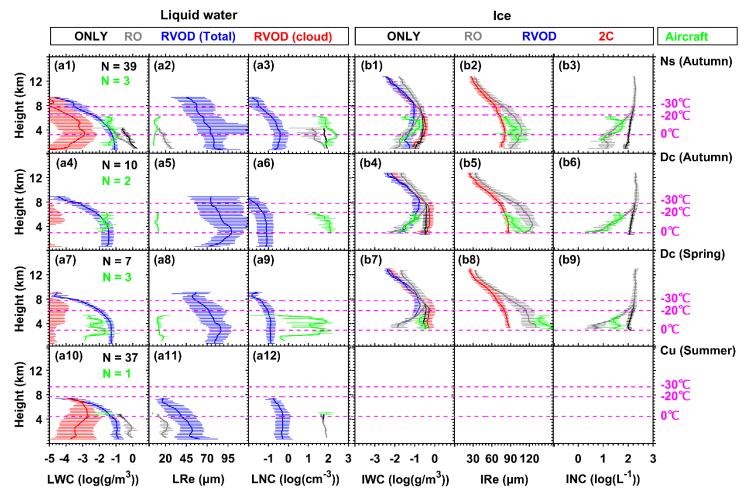Editor: 谢佳 Author: Time: 2023-10-19 Number of visits :147
Vertical profiles of cloud microphysical properties importantly determine the lifetime and precipitation rate of clouds. The 94-GHz cloud profiling radar onboard the CloudSat satellite can measure the vertical profile of radar reflectivity, from which the microphysical properties of cloud can be retrieved. The retrievals bear variations due to various assumptions and auxiliary products used. This study targets on the mid-latitude clouds in the northern hemisphere, and intercompares the CloudSat products describing the vertical profiles of cloud microphysics and evaluate the uncertainties for each retrieval algorithm, with further evaluation by aircraft in-situ observations over the North China Plain region during 2013-2017.

Figure 1. Comparison of liquid and ice cloud microphysical properties, including cloud liquid/ice water content (LWC/IWC), liquid/ice effective radius (LRe/IRe), and liquid/ice number concentration (LNC/INC) between aircraft observations (green colour) and different CloudSat retrievals. The line and error bars represent the median, 25th and 75th percentiles at each altitude bin (240m), respectively. The horizontal dash lines indicate the mean altitude of 0, -20 and -30⁰C in each season. N denotes the profile numbers for the different products of the respective cloud types. The product with/without performing phase apportion (RO and RVOD/ONLY and 2C), and with/without joint constraint product (RVOD and 2C/ONLY and RO).
In this study, Pan et al (2023) compared and analyzed the microphysical properties of different CloudSat retrievals between liquid and ice cloud with in-situ aircraft observations (Figure 1). For those retrieval products performing phase apportion, the ambient temperature-based linear apportioning on mixed-phase clouds can produce reasonable estimation on ice water content, apart from the heavily precipitating clouds. The retrieved liquid water content constrained by cloud optical depth well matched in-situ observations, however its effective size is overestimated (hereby underestimating the number concentration of water droplets) because of the influence of larger precipitating hydrometeors on size distribution. The CPR-only retrieval can well produce the effective diameter and number concentration of ice for deep convection clouds, but using additional lidar constraint underestimates the effective radius due to the intense attenuation by thick clouds. The analysis here suggests the appropriate parameters from various products for different cloud types, and provides guidance for future development of retrieval algorithms on vertical profiles of cloud microphysical properties.
This study from Prof. Dantong Liu’s group has been published at Journal of Geophysical Research: Atmospheres (10.1029/2023JD039093). This work was supported by the National Natural Science Foundation of China and National Key Research and Development Program of China.
For Details: Baiwan Pan, Dantong Liu, Yuanmou Du, Delong Zhao, Kang Hu, Shuo Ding, Chenjie Yu, Ping Tian, Yangzhou Wu, Siyuan Li, and Kanike Raghavendra Kumar. Intercomparisons on the Vertical Profiles of Cloud Microphysical Properties from CloudSat Retrievals over the North China Plain. Journal of Geophysical Research: Atmospheres, 2023,128, e2023JD039093.
LINK: https://doi.org/10.1029/2023JD039093
